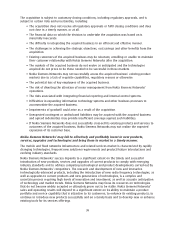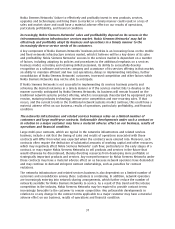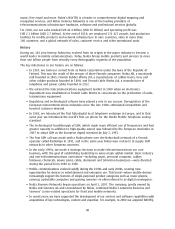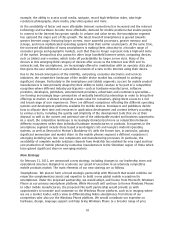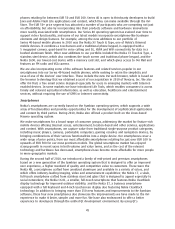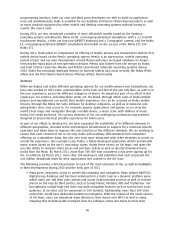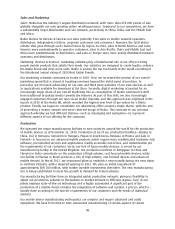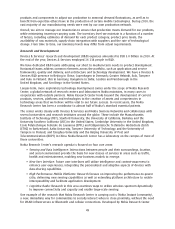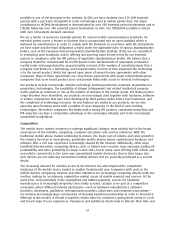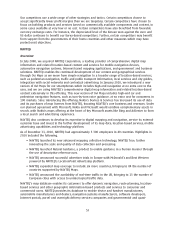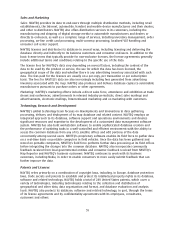Nokia 2010 Annual Report Download - page 46
Download and view the complete annual report
Please find page 46 of the 2010 Nokia annual report below. You can navigate through the pages in the report by either clicking on the pages listed below, or by using the keyword search tool below to find specific information within the annual report.phones retailing for between EUR 50 and EUR 200. Series 40 is open to thirdparty developers to build
Java and Adobe Flash Lite applications and content, which they can make available through the Ovi
Store. The EUR 50+ price segment has attracted a number of participants who are competing not just
on affordability, but also by incorporating into their products software and hardware innovations
more readily associated with smartphones. Our Series 40 operating system has evolved over time to
support richer functionality, and some of our latest models incorporate smartphonelike hardware
elements and design features. For example, among the new additions to our portfolio of
Series 40based mobile phones in 2010 was the Nokia X3 Touch & Type, one of Nokia’s thinnest
mobile devices. It combines a touchscreen and a traditional phone keypad, is equipped with a
5 megapixel camera, quadband for voice calling and 3G, HSPA and WiFi connectivity for data in a
bushed aluminum finish. Other new additions to our portfolio included the Nokia C3 Touch & Type, a
stainless steel device, which also combines the touch screen and traditional phone keypad, and the
Nokia 2690, our lowestcost device with a memory card slot, and which gives access to Ovi Mail and
features an FM radio and VGA camera.
We are also incorporating some of the software features and related services popular in our
smartphones into our Series 40based mobile phones, while seeking to retain the simplicity and
easeofuse of the devices’ user interface. These include the new Ovi web browser, which is based on
the browser technology that we obtained as part of our acquisition in 2010 of Novarra, Inc. We also
offer Ovi Mail, a free email service designed especially for users in emerging markets with Internet
enabled devices. In some markets we have introduced Life Tools, which enables consumers to access
timely and relevant agricultural information, as well as education, healthcare and entertainment
services, without requiring the use of GPRS or Internet connectivity.
Smartphones
Nokia’s smartphones are currently based on the Symbian operating system, which supports a wide
array of functionalities and provides opportunities for the development of sophisticated applications
and content by third parties. During 2010, Nokia also offered a product built on the Linuxbased
Maemo operating system.
We make smartphones for a broad range of consumer groups, addressing the market for featurerich
mobile devices offering Internet access, entertainment, locationbased and other services, applications
and content. With smartphones, we capture value from traditional singlepurpose product categories,
including music players, cameras, pocketable computers, gaming consoles and navigation devices, by
bringing combinations of their various functionalities into a single device. Our smartphones cover a
wide range of price points, from our most affordable smartphones retailing for just over EUR 100 to
upwards of EUR 500 for our most premium models. The global smartphone market has enjoyed
strong growth in recent years in both volume and value terms, and as the cost of the relevant
technology and hardware has decreased, smartphones have become more affordable for more people
in more geographic markets.
During the second half of 2010, we introduced a family of midpriced and premium smartphones
based on a new generation of the Symbian operating system that is designed to offer an improved
user experience, a higher standard of quality and competitive value to consumers. These were the
Nokia N8, a smartphone crafted from anodized aluminum and available in a variety of colors, and
which offers industryleading imaging, video and entertainment capabilities; the Nokia C7, a sleek,
fulltouch smartphone crafted from stainless steel and glass that is designed to appeal especially to
social networkers; the Nokia C601, a smaller, fulltouch smartphone that features Nokia ClearBlack
display technology for improved outdoor visibility; and the Nokia E7, a business smartphone
equipped with a full keyboard and 4inch touchscreen display also featuring Nokia ClearBlack
technology. In addition to bringing more than 250 new features and improvements to the Symbian
software, these four new smartphones also showcase the improvements we have made to the Ovi
experience to make it faster, simpler and more fun. We have also endeavored to offer a better
experience to developers through the unified Qt development environment. By using Qt’s
45



